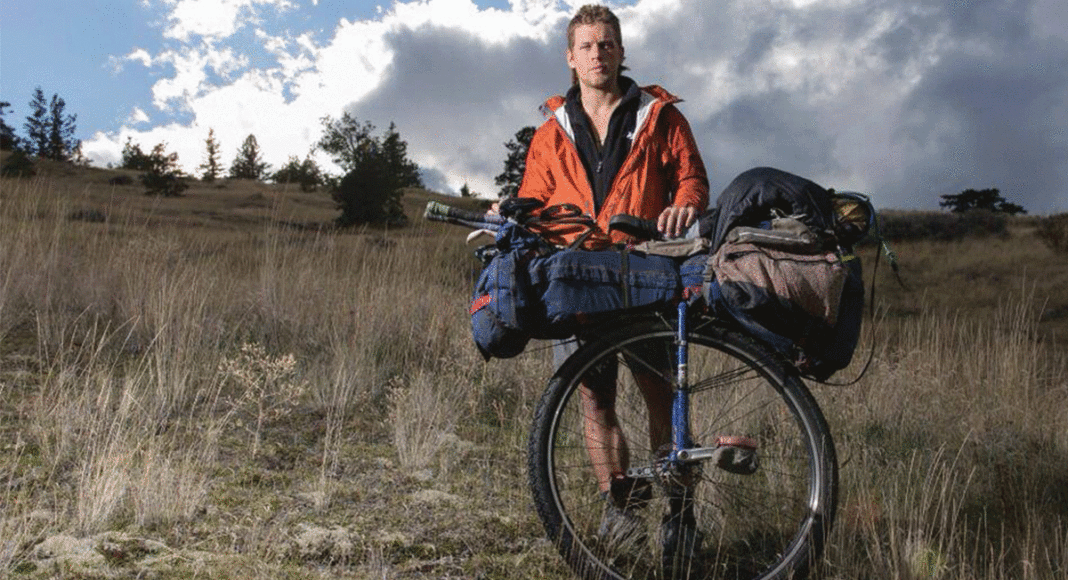If the the story of Luno, a precocious boy who decides to unicycle to South America, doesn’t immediately charm you as you flip through the children’s book The Sustainable Adventures of Luno! The One Who Rode to South America on One Wheel, it might help to know that Santa Cruz-based author Cary Gray drew all 34 pages of whimsical illustrations with his feet.
What’s even more impressive is that the fictional Luno’s epic journey is based on Gray’s real-life 18,000-mile unicycle trip from Baltimore to Columbia, unofficially the longest trip made by unicycle.

In July of 2013—without previously having done any long-distance unicycling, and with only one bicycling trip up the East Coast five years earlier—Gray planned the trip basically to see if it could be done. The then 24-year-old Gray hopped onto his custom-built, all-terrain unicycle, balancing a set of self-designed panniers, and set off for South America.
Almost immediately, he got lost.
“I realized that you can’t exactly ask people, ‘Which way to South America?’” admits Gray with a wry half-smile.
Traveling on one wheel posed its own set of challenges, in addition to the normal factors one must consider on an overland trip of this magnitude—the most problematic being speed. While cyclists can conserve energy by coasting and standing for stretches at a time, it’s impossible to coast on a unicycle. Gray had to stop when he got tired, lengthening the journey considerably. “In a stretch, I could do an average of 10 miles before I had to take a break. Anything more than that and it became incredibly painful, especially in the beginning,” he explains.
However, Gray says he didn’t get lost again the rest of his trip. “I decided there’s no such thing as a detour. It’s all a matter of perspective.”
In June of 2014, Gray arrived in Colombia. Although he had intended to continue through the continent, his passport was stolen, and he returned home. But his passion for long-distance unicycling was fully aflame by this point, and it wasn’t long before he found himself on another cross-continent journey, this time to Juneau, Alaska.
It was on this “second leg” of his journey that Gray experienced a change in focus from inward to outward. “The first mission was to challenge people’s perspectives and figure myself out—and get to South America. On my way to Alaska, my attitude shifted. I needed to share my story,” he says.
If he had reached South America by the power of his own two feet, Gray thought, why not continue to challenge his perspective and illustrate a book about his journey in the same way?
Gray began giving talks to elementary school kids about his trip. “My message was to get out there, that anything is possible. The kids also wanted to know what I ate, which led to discussion about nutrition and healthy eating,” says Gray. “I wanted to share the message to take care of yourself, each other and the world.”
An artist by trade, he was inspired to create the book as a way to document his journey and create a visual aid for children. If he had reached South America by the power of his own two feet, Gray thought, why not continue to challenge his perspective and illustrate a book about his journey in the same way? “I felt like a unicycle is to a bicycle what a foot is to hand,” he says. “I thought, ‘Why not?’”
The results are playful watercolor images depicting a sojourn through rain, snow, alpacas and the temples of Machu Picchu. The character of Luno enthusiastically refutes naysayers who can’t conceive how he will complete his journey—one grown-up figure’s head literally explodes in a burst of popcorn at the idea—with an exuberant “Anything is possible!” Gray peppers the imaginative expedition with smaller text intended to be read by an adult or older child about environmental stewardship and cultural notes, like not to feed wild animals and the importance of rivers as water sources.
“The book is partially a tool for me, and partially a tool for kids. I wanted something in which I could use my talents in art and writing, and something that would define me and the trip in a concrete form, a visible aid you could look at. Since I was trying to spread this message, I wanted something that I could go back to as a tool for that,” says Gray.
Luno’s namesake is Luna, Gray’s unicycle. He explains that the names share a Latin root with “lunacy”—very fitting, considering how crazy his trip sounds to most people. Like himself, Gray admits, “You can kinda get the sense that he’s sort of a loon-ball.”
Read more about Gray’s journey and order books at caryoutthere.wordpress.com.
Update 12/14/16 11:20 am: Quotation updated for accuracy.













